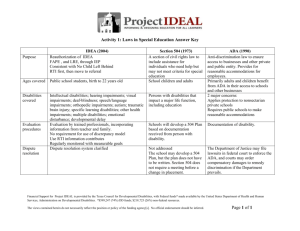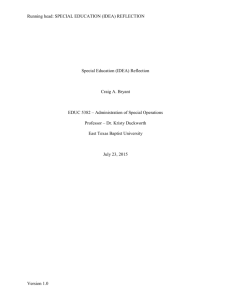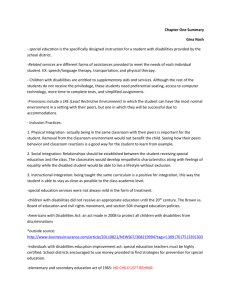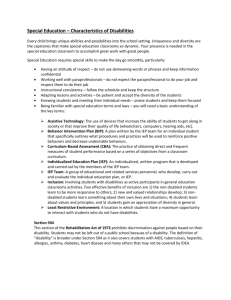wiki - w301math-ATresources - home
advertisement
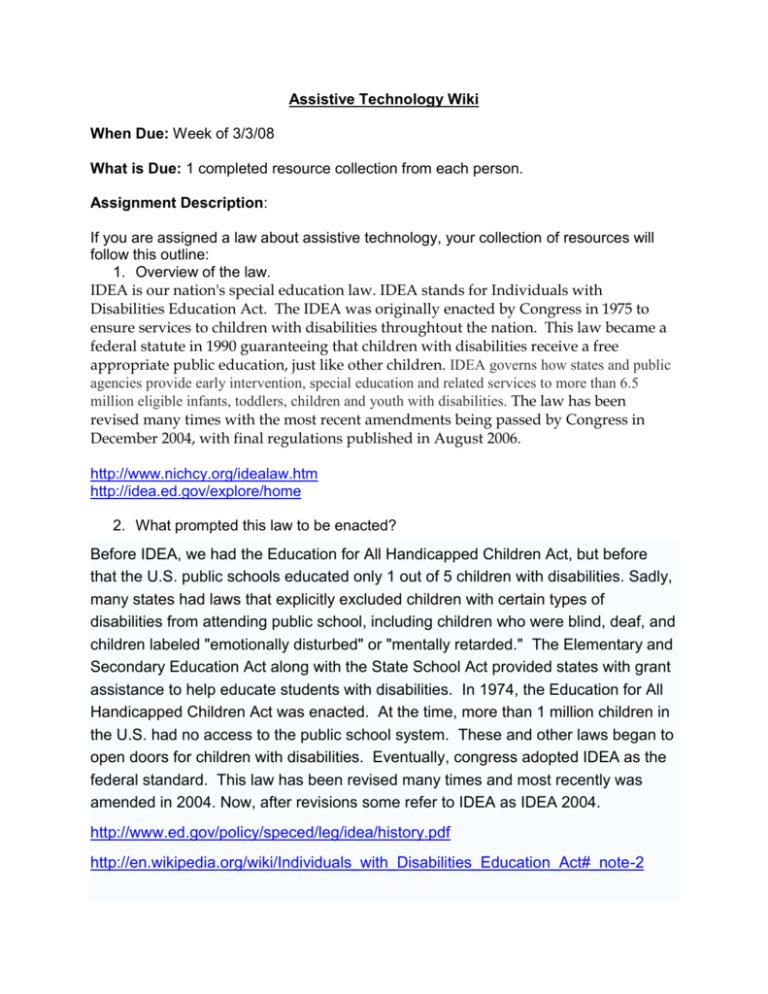
Assistive Technology Wiki When Due: Week of 3/3/08 What is Due: 1 completed resource collection from each person. Assignment Description: If you are assigned a law about assistive technology, your collection of resources will follow this outline: 1. Overview of the law. IDEA is our nation's special education law. IDEA stands for Individuals with Disabilities Education Act. The IDEA was originally enacted by Congress in 1975 to ensure services to children with disabilities throughtout the nation. This law became a federal statute in 1990 guaranteeing that children with disabilities receive a free appropriate public education, just like other children. IDEA governs how states and public agencies provide early intervention, special education and related services to more than 6.5 million eligible infants, toddlers, children and youth with disabilities. The law has been revised many times with the most recent amendments being passed by Congress in December 2004, with final regulations published in August 2006. http://www.nichcy.org/idealaw.htm http://idea.ed.gov/explore/home 2. What prompted this law to be enacted? Before IDEA, we had the Education for All Handicapped Children Act, but before that the U.S. public schools educated only 1 out of 5 children with disabilities. Sadly, many states had laws that explicitly excluded children with certain types of disabilities from attending public school, including children who were blind, deaf, and children labeled "emotionally disturbed" or "mentally retarded." The Elementary and Secondary Education Act along with the State School Act provided states with grant assistance to help educate students with disabilities. In 1974, the Education for All Handicapped Children Act was enacted. At the time, more than 1 million children in the U.S. had no access to the public school system. These and other laws began to open doors for children with disabilities. Eventually, congress adopted IDEA as the federal standard. This law has been revised many times and most recently was amended in 2004. Now, after revisions some refer to IDEA as IDEA 2004. http://www.ed.gov/policy/speced/leg/idea/history.pdf http://en.wikipedia.org/wiki/Individuals_with_Disabilities_Education_Act#_note-2 3.What are the law’s provisions? IDEA provides federal financial assistance to state and local educational agencies for special education and related services to students with disabilities. One of the first provisions of the law to examine is eligibility for services. Not everyone with a disability qualifies for IDEA. IDEA defines a "child with a disability" as a child with mental retardation, hearing impairments, speech or language impairments, visual impairments, serious emotional disturbance, orthopedic impairments, autism, traumatic brain injury, other health impairments, or specific learning disabilities; and, who needs special education and related services." 20 U.S.C. § 1401(3)(A). The next main provision within IDEA is providing a Free Appropriate Public Education (FAPE). FAPE insures that each specific child receives an individualized educational program. To provide FAPE, schools must provide students with an “…education that emphasizes special education and related services designed to meet their unique needs and prepare them for further education, employment, and independent living.” 20 U.S.C. §1400(c)(5)(A)(i). Along with FAPE, students are provided an Individualized Education Plan (IEP). The IEP specifies the services to be provided and how often, describes the student's present levels of performance and how the student's disabilities affect academic performance, and specifies accommodations and modifications to be provided for the student. An IEP must be designed to meet the unique educational needs of that one child in the Least Restrictive Environment which is another provision of IDEA. The LRE usually is the same environment that other children learn in. Some other related services that fall under IDEA can include anything from transportation, counseling, school health services, and parent participation just to name a few. http://en.wikipedia.org/wiki/Individuals_with_Disabilities_Education_Act#_ref-11 20 U.S.C. § 1401(3)(A) 3. What are the law’s implications for public schools? 4. An annotated list of resources about the law 1. http://en.wikipedia.org/wiki/Individuals_with_Disabilities_Education_Act#_ref11 2. 20 U.S.C. § 1401(3)(A) 3. http://en.wikipedia.org/wiki/Individuals_with_Disabilities_Education_Act#_note -2 4. http://www.ed.gov/policy/speced/leg/idea/history.pdf 5. http://www.nichcy.org/idealaw.htm 6. http://idea.ed.gov/explore/home http://w301atresources.wikispaces.com/Individuals+with+Disabilities+Education+Act+%28IDEA%2 9+P.L.+94-142 http://www.museumofdisability.org/html/exhibits/society/exb_law.html http://www.doe.state.in.us/ http://idea.ed.gov/index.jhtml?src=a



